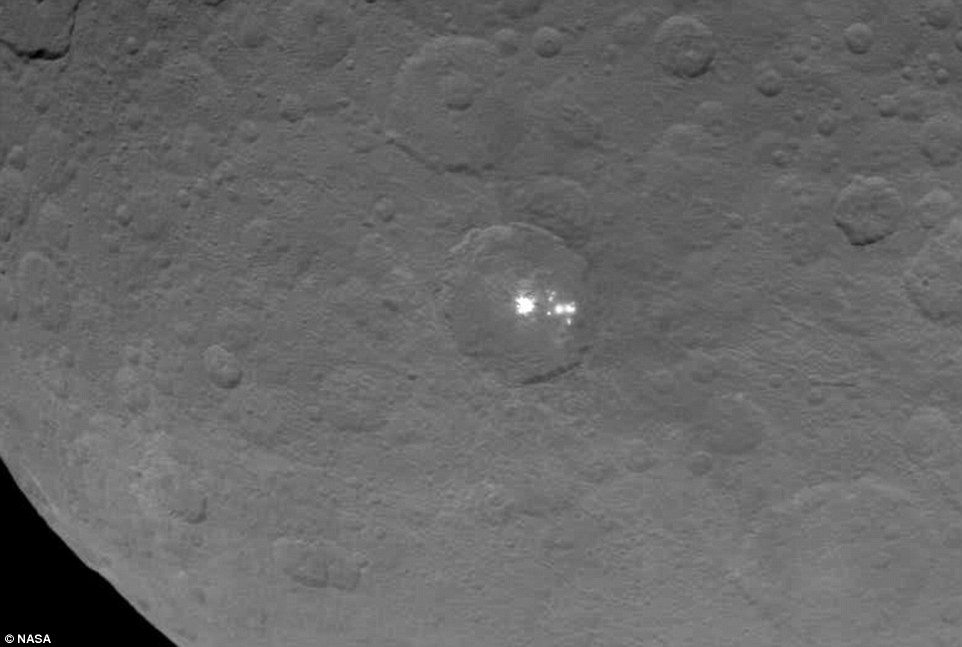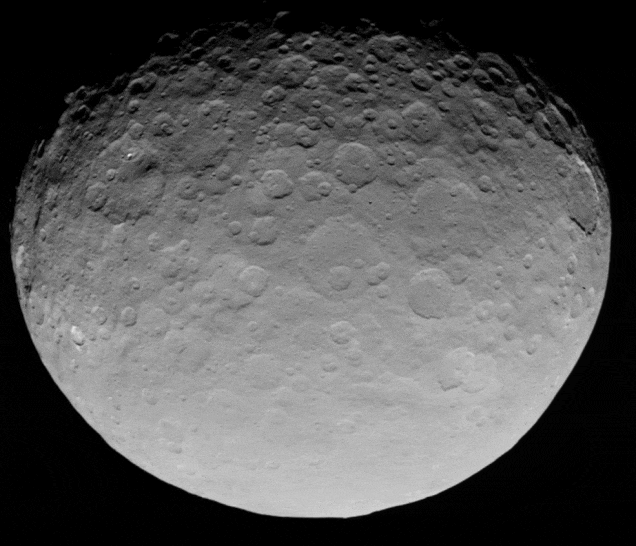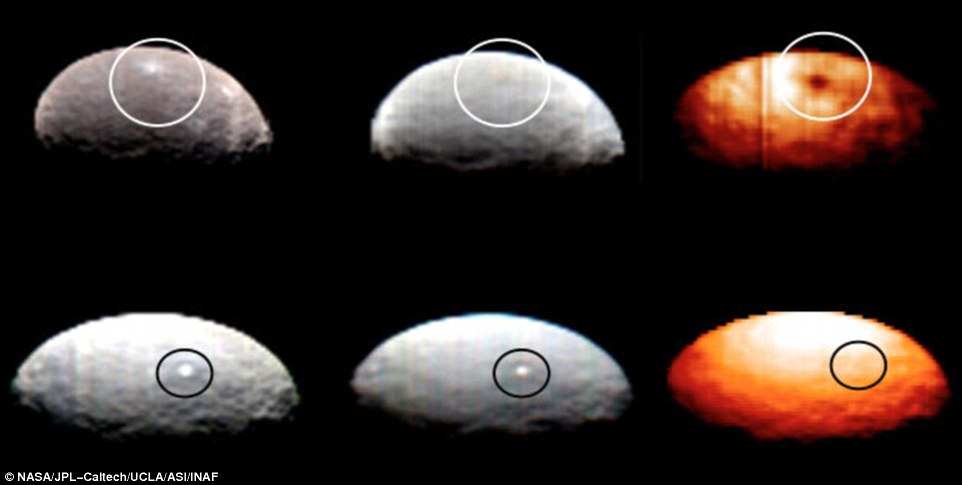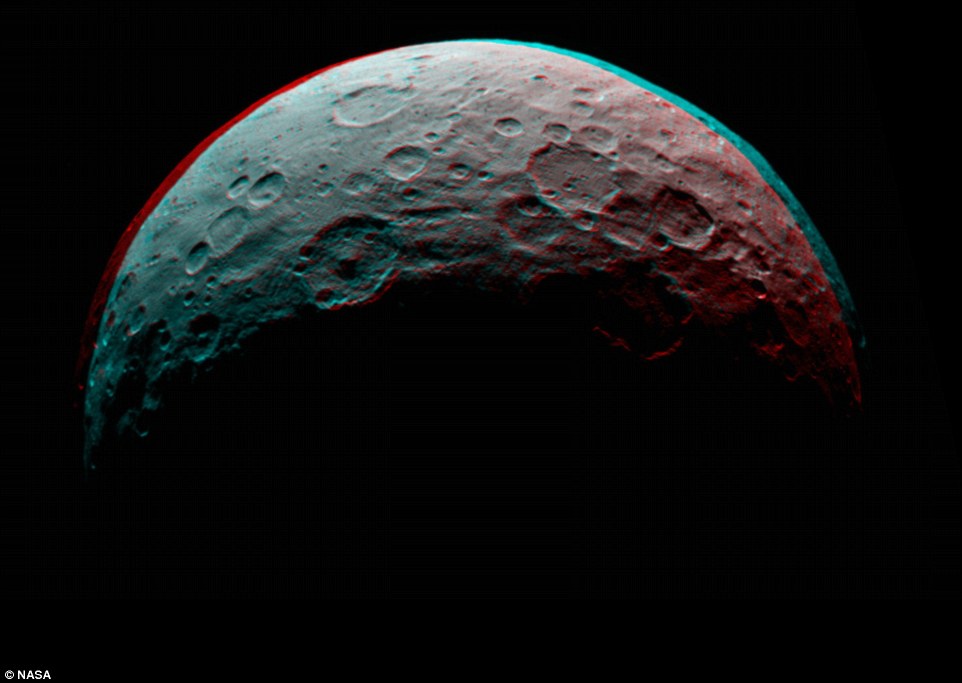Вход / Регистрация
23.12.2024, 00:05
Главная » 2015 Май 26 » Mystery ‘alien’ lights on Ceres as never seen before: Dawn probe zooms in on bright flashes
15:33 Mystery ‘alien’ lights on Ceres as never seen before: Dawn probe zooms in on bright flashes |
 The mystery 'alien' lights flashing on Ceres' surface have been revealed in unprecedented detail - and they seem to confirm the existence of ice on the dwarf planet. Over the weekend, the Dawn probe swooped down to a distance of 4,500 miles (7,200km) above Ceres' surface to capture the bright spots in high resolution. The image confirms earlier observations that the brights spots, originally thought to come as a pair, are in fact a series of several smaller lights grouped together. Experts, however, are still at a loss to explain the composition and source of the bright spots, with theories ranging from salt flats to giant ice volcanoes. They also have no idea why they exist on just one part of the planet, or why they are grouped in this way. 'Dawn scientists can now conclude that the intense brightness of these spots is due to the reflection of sunlight by highly reflective material on the surface, possibly ice,' said Christopher Russell, principal investigator for the Dawn mission from the University of California, Los Angeles. Despite still being baffled by its nature, these images offer scientists new insights into crater shapes and sizes, and a host of other intriguing geological features on the surface. Salt flats or ice seem to be the predominant theories at the moment, with the bright spots appearing to reflect incoming sunlight towards the spacecraft's cameras. Until Dawn gets closer, though, it's unlikely the mystery will be resolved. 'It's too early to say what they are,' Dr Marc Rayman, Dawn's mission director and chief engineer, told MailOnline. 'Some people have offered they might be ice, but I don't consider that necessarily the most likely explanation.' Dr Rayman says he favours the theory that they could be 'salty deposits', left over from perhaps saltwater' on the surface. But one thing that can be ruled out is that they are their own sources of light. Dr Rayman is certain they are simply reflecting sunlight. 'They're mysterious but not bizarre,' he said. Dawn has now finished its first mapping orbit, in which it completed one 15-day full circle around Ceres while making a host of new observations with its scientific instruments. On May 9, the spacecraft powered on its ion engine to begin the month-long descent toward its second mapping orbit, which it will enter on June 6. In this next phase, Dawn will circle Ceres about every three days at an altitude of 2,700 miles (4,400km) - three times closer than the previous orbit. During this phase, referred to as Dawn's survey orbit, the spacecraft will comprehensively map the surface to begin unraveling Ceres' geologic history and assess whether the dwarf planet is active. The spacecraft will pause twice to take images of Ceres as it spirals down into this new orbit. Up until December it will periodically descend lower and lower until it reaches an altitude of just 225 miles (260km) above the surface, with images 100 times better than those taken so far. This is lower than the orbital height of the ISS around Earth – and will allow Dawn to snap glorious images of Ceres' surface, including its mysterious bright spots.  It is the first mission to visit a dwarf planet, and the first to orbit two distinct solar system targets. It studied giant asteroid Vesta for 14 months in 2011 and 2012, and arrived at Ceres on March 6, 2015. Both Vesta and Ceres are in the main asteroid belt between Mars and Jupiter, and were on their way to forming planets before their development was interrupted - likely by the gravity of Jupiter. |
| Категория: Space | Просмотров: 1303 | |
| Всего комментариев: 0 | |





